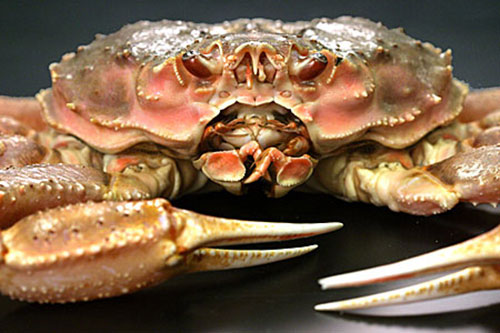|
Fish Factor Where have all the crab gone?By LAINE WELCH
November 11, 2015
State managers for several years have been tracking a huge plug of crab that appeared poised to enter the 2016 Tanner fishery, but based on this summer’s surveys, the crab have failed to materialize.
Tanner Crab
Stichert speculate the Tanner drop off is due to increased predation by growing numbers of cod, pollock and flatfish throughout the Gulf regions, “We’re seeing continued recruitment into the fishery, meaning juvenile and small crab generations are being spun off every year,” he said. “We don’t completely understand why those crab aren’t maturing through the population to get to the legal size.” It takes about six years for the Gulf Tanner crab to grow to their mature, two pound size. A fleet of 50 or more Kodiak boats and about 30 at the Alaska Peninsula target Tanners. The mid-January fishery, which in past years has dwindled to around one million pounds, is usually worth several million dollars to fishermen. “It’s a bummer because the money is good and it’s just down right fun to catch local crab,” said Tyler O’Brien, a Kodiak fisherman. “I understand why we need to stand down another year, but I just hope they are able to do good surveys with the tight budget situation.” By the way -- Tanner crab is spelled with a capitol T because it is named after discoverer Zera Luther Tanner, commander of the research vessel Albatross, which explored Alaska waters in the late 1800s. Details are just now coming to light on the Trans-Pacific Partnership, (TPP) which includes a dozen countries and covers 40 percent of the global economy. One thing is clear -- Alaska seafood will net a big benefit from the trade pact signed last month. Supporters claim it will create a powerful economic bloc with reduced trade barriers for all kinds of goods and data, including lowered or zeroed out tariffs, the taxes on imports that make them more expensive to consumers. For pollock surimi products and pollock roe going to Japan, for example, tariffs of 4.2 percent on both into would immediately go to zero upon the agreement going into place, said Ron Rogness, a spokesman for American Seafoods whose fleet fishes for pollock in the Bering Sea. Rogness said the new agreement also will remove a bone of contention for pollock. “It’s been a point of contention for the U.S. industry that imports of warm water surimi from Asian countries like Thailand have been coming in at a favorable rate of duty of 2% relative to our 4.2 percent. Given the fact that our fisheries are much more sustainably managed and there have been questionable labor practices in some of these Asian fisheries, it’s been a sore spot that they’ve had a more favorable tax situation entering Japan,” he explained. The value of U.S. surimi exports to Japan last year was $67,722,865 and $156,830,520 for pollock roe. “Multiply that by 0.042, and the combined tariffs equals $9.4 million,” Rogness said. Currently, the seafood tariffs across the partnership countries range from 3.5 to 11 percent An Intrafish chart shows that the tax on sockeye salmon – now at 3.5% - would also be zeroed out immediately. For other salmon species, the import tax would be gradually reduced and eventually eliminated. Tariffs on king and snow crab, herring roe and frozen cod also would be removed immediately. The TPP still has a long way to go. The trade deal must still be ratified by each country, including the U.S., and it faces stiff opposition on several fronts. Rogness predicted it will be at least two years before the TPP is approved. The Pacific halibut fishery ended for the year on Saturday, November 7th, with nearly the entire 17 million pound Alaska catch limit taken by longliners. Halibut prices remained in the $6-$7 range (or higher) in major ports since the fishery opened in early March. Kodiak was poised to take the title of #1 port for halibut landings from Homer by just a few thousand pounds. The sablefish fishery also ends on November 7th. Southeast Alaska’s demersal shelf rockfish season opened November 8 with an 88,000 pound quota. That fishery includes yellow eye, canary and five other kinds of tasty rockfish. Also ongoing in Southeast are dive fisheries for urchins, geoduck clams and sea cucumbers, which are going fast. Just 380,000 pounds remained in the nearly 1.5 million pound sea cuke quota. Crabbers are still dropping pots for Dungeness and some regions remain open for big spot shrimp. Trollers continue targeting Chinook in the winter fishery, which has seen prices increase to $6.65 a pound. Pollock fisheries in the Bering Sea and Gulf of Alaska ended for the year on November 1, while fishing continues for cod, flounders and other groundfish. The Bristol Bay red king crab fishery has been fast and phenomenal with nearly all of the nine million pound quota taken in less than three weeks A total of 65 boats signed on for the fishery with a payout reported at $7 a pound for red king crab, up 90 cents from last year. Bering Sea boats will likely switch to the 20 million pound bairdi Tanner crab fishery after the red king closure. Looking ahead– fishery managers are calling for another big salmon run next summer to Bristol Bay of more than 46 million sockeyes, which would yield a catch of 31.24 million reds. Finally, the Board of Fisheries meets Nov 30- Dec 1 in Anchorage. The focus this cycle is on Alaska Peninsula, Chignik, Aleutian Islands and Bering Sea state water cod fisheries. Comments can be submitted to the Fish Board through Nov. 19.
Laine Welch ©2015 www.alaskafishradio.com SitNews ©2015 Stories In The News Ketchikan, Alaska
|
||

